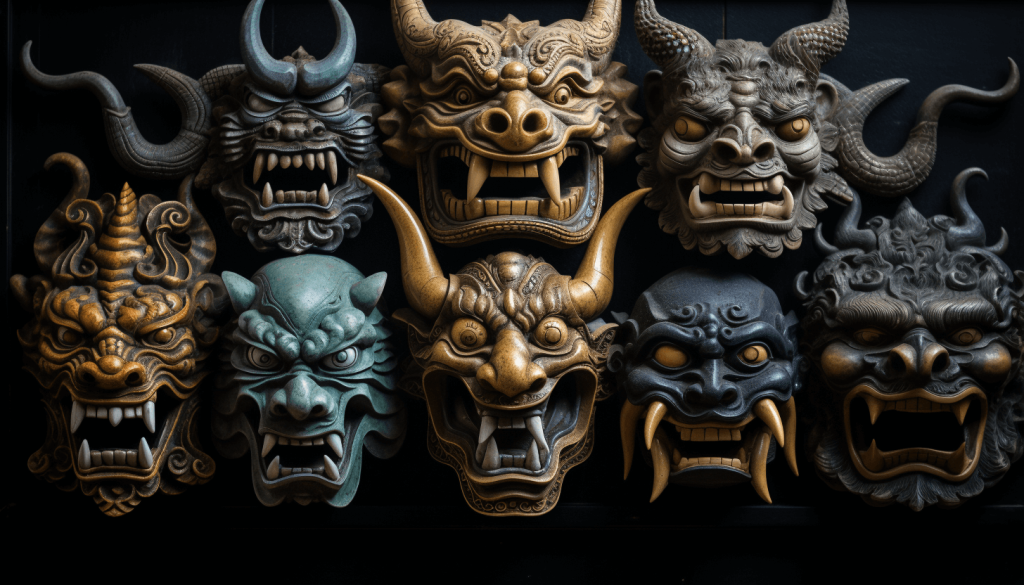Understanding Demonology: A Beginner’s Guide
Welcome, curious soul! You’re about to embark on a captivating journey into demonology—a study that spans continents, cultures, and centuries. Have you ever wondered why some names send shivers down your spine or why certain tales have endured the test of time? That’s the allure of demonology.
The term demonology might sound eerie, but it’s the study of demons and other supernatural beings. These entities are not just confined to the stories whispered around campfires; they’ve been integral to religious texts, folklore, and countless traditions worldwide.
Not all demons are depicted as evil in every culture. In some traditions, they’re seen as mere messengers or even protectors!
From the mysterious tales of the East to the legends of the West, demons have been both feared and revered. These supernatural beings, irrespective of their intent—benevolent or malevolent—offer a fascinating window into how societies interpret the unknown. It’s not just about the entities themselves but also the values, fears, and aspirations of the cultures that believe in them.
“Demonology isn’t just about studying ‘monsters’; it’s about understanding our deepest fears and beliefs.”
Frequently Asked Questions
What is the origin of the term ‘demon’?
The term ‘demon’ derives from the Ancient Greek word ‘daimon,’ originally referring to a spirit or divine power, not necessarily evil.
Are demons universal across religions?
While the concept of supernatural beings exists in almost all religions, their characteristics, roles, and stories differ widely.
Whether you’re an academic, a writer, or someone with a sheer curiosity, understanding demonology provides rich insights. It’s not just about spirits and otherworldly realms but a reflection of humanity’s attempt to understand and categorize the vast unknown.
Ready to dive deeper? Hold on to that curiosity, and let’s journey further into the myriad stories, interpretations, and mysteries that await in the world of demonology.
Female Demon Names List: From Lilith to Jezebel
Demons, while often associated with evil intentions, come in all forms and from various cultures. Among them are powerful female figures whose legends and backstories have left an indelible mark on history, culture, and myth. Dive into the world of female demonology and uncover the tales of some of the most intriguing female demons.
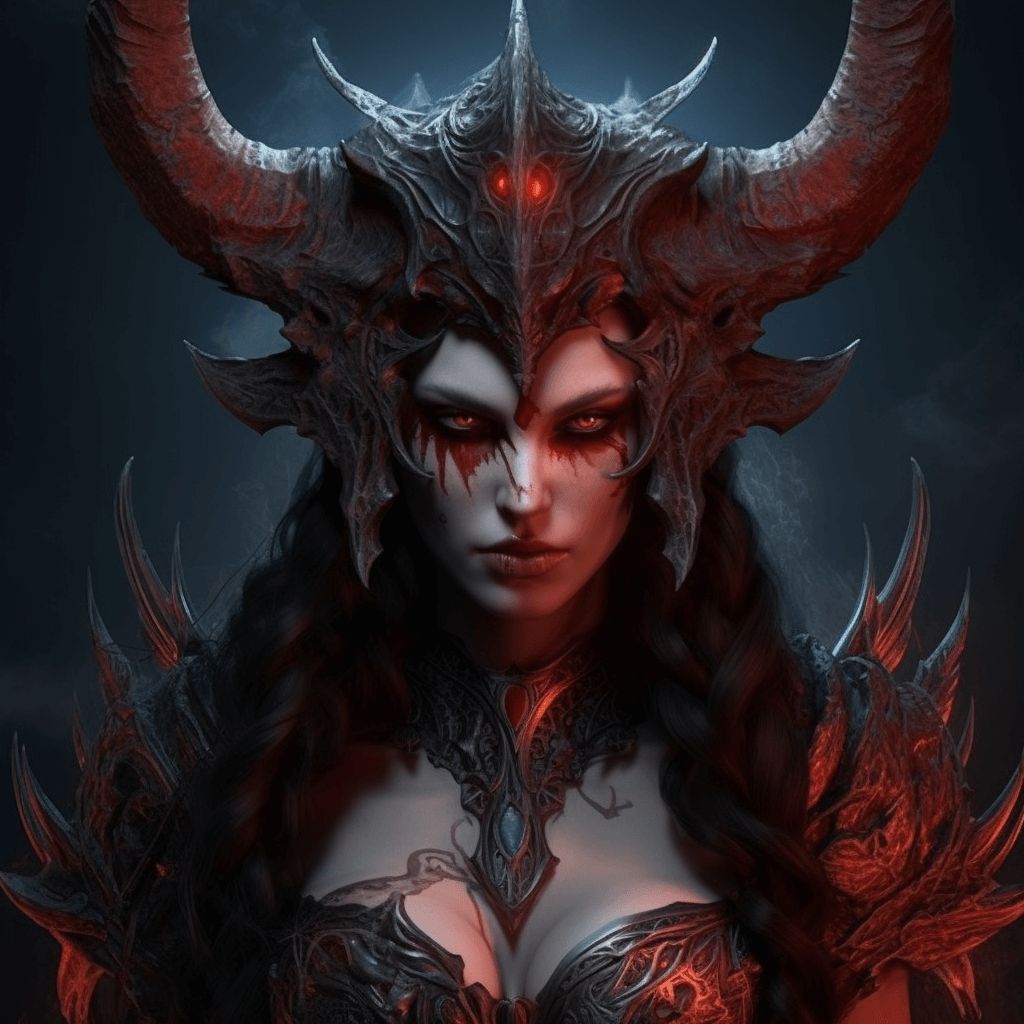
- Lilith: Originating from Judeo-Christian lore, Lilith represents an early symbol of female defiance. As legend has it, she was Adam’s original partner before Eve. Still, she left Eden due to her refusal to submit. Tales transformed her into a demon with a penchant for harming infants, often depicted with avian characteristics.
- Lamia: A poignant tale from Greek mythology tells of Lamia, once a beautiful queen who became an object of Zeus’s affection. Her ensuing curse by the jealous Hera transformed her into a child-eating demon. Her sorrow and envy drove her to seek and consume other children as well.
- Jezebel: Jezebel’s narrative is deeply rooted in biblical stories. This queen, notorious for her misdeeds, isn’t a typical demon. Yet her dedication to the pagan god, Baal, and her misleading influence on Israel paints her as an emblem of treachery and false worship.
- Agrat Bat Mahlat: Delving into Jewish folklore, we encounter Agrat Bat Mahlat, one of the four sacred prostitution angels. Legends tell of her performing dances before the Lord and weaving her charms around mortals. Her frequent dealings with witches, especially during the Sabbath, have made her a figure of enchantment and allure.
- Abyzou: A figure found in both Jewish and Christian tales, Abyzou has an ominous reputation for causing miscarriages and the death of infants. Her portrayal, often as a creature with serpentine or fish-like attributes, underscores her dread in the world of demonology.
- Lamashtu: Delving deep into Mesopotamian myths, Lamashtu emerges as a terrifying female demon known to harm mothers and children. Often depicted with a lion’s head and bird’s feet, she’s said to snatch away newborns, drink the blood of men, and cause harm to pregnant women.
- Naamah: This seductive demoness from Hebrew lore is both enchanting and eerie. As one of the queens of the demons and a mistress of the demon king Asmodeus, Naamah is known for her beauty and her role in leading the righteous astray with her charms.
- Gorgon: From Greek mythology, the term ‘Gorgon’ actually refers to three sisters, with Medusa being the most famous. Characterized by the hair of living snakes and a gaze that can turn any onlooker to stone, the Gorgons epitomize terror and allure in equal measure.
- Dantalion: While not traditionally female, Dantalion’s appearance is unique. In demonology, Dantalion is a powerful Duke of Hell, depicted with multiple faces, each expressing a different emotion. This demon teaches arts and sciences and can influence thoughts and emotions, making it a master manipulator.
- Astarte: Heralding from ancient Near Eastern traditions, Astarte is the goddess of love, war, and fertility. Her influence stretches from the Canaanite to the Phoenician cultures. Over time, she became demonized in some lore but remains a symbol of strength and femininity.
- Eisheth: Another queen of demons from Jewish lore, Eisheth, is known for her seductive nature. She roams the night with her fellow demonic queens, seeking souls to ensnare with her beauty. Yet, beneath her charms lies a predatory nature, always searching for the next soul to captivate.
- Gremory: Within the annals of demonology, Gremory stands out as a powerful duchess of Hell. Often depicted as a beautiful woman riding a camel, she is said to have the power to reveal hidden treasures and to provide love from women.
- Batibat: A creature of nightmares from Filipino folklore, Batibat is a vengeful demon known to reside in trees. When these trees are cut down to make homes, Batibat moves in, too, causing sleep paralysis and nightmares among the residents.
- Buer: A being of contradiction, Buer is depicted with a lion’s head and five goat legs, allowing it to walk in every direction. Hailing from the Pseudomonarchia Daemonum, a directory of demons, Buer teaches natural and moral philosophy and can heal the sick.
- Hecate: The ancient Greek goddess of magic, crossroads, and necromancy, Hecate is often accompanied by spirits and hounds. Her knowledge of herbs and poisonous plants makes her a protector and a figure to be feared. Later traditions often conflated her with witchcraft and demonology.
- Medusa: Perhaps the most iconic among the Gorgons, Medusa’s gaze is said to turn anyone who meets it to stone. Once a beautiful maiden, she was transformed into a serpent-haired monster after incurring the wrath of Athena.
- Allatu: Originating from Akkadian and Sumerian myths, Allatu is an underworld goddess. As a counterpart to the god Nergal, she reigns over the domain of the dead, ensuring that balance and order are maintained in the afterlife.
- Rangda: From Balinese mythology, Rangda is a fearsome witch queen and the embodiment of evil. Locked in an eternal battle with Barong, the force of good, their conflict represents the balance of good and evil in the world.
- Aeshma: From ancient Zoroastrian beliefs, Aeshma embodies violence and wrath. Often referred to as the “demon of the bloody mace,” his presence brings forth conflict and strife.
- Andras: Within the grimoires, Andras stands as a marquis of Hell. Portrayed as an angel with the head of an owl or raven, riding a strong black wolf, he sows discord and can kill the unwary with a single motion.
- Belphegor: Associated with the deadly sin of Sloth, Belphegor is a demon who often appears as a beautiful young woman or, sometimes, a monstrous bearded demon with horns. Legends suggest that he tempts people by means of laziness and dreams of grandeur.
- Asmodeus: This king of demons is a central figure in many mythologies, from Jewish to Christian lore. Often linked with lust and impurity, Asmodeus is said to thwart marital relationships and spread wickedness. His depiction varies, sometimes seen with three heads – a man, a ram, and a bull.
- Jorogumo: A fascinating creature from Japanese folklore, Jorogumo translates to ‘binding bride’ or ‘spider woman.’ This shape-shifting spider entices her victims with beauty, only to bind them up and consume them once they’re trapped in her web.
- Uvall: Holding the rank of duke in demonology, Uvall is known to promote friendships among foes. Often pictured riding a camel, he can reveal the past, present, and future, making him a figure of excellent knowledge and foresight.
- Stolas: This high-ranking demon is often associated with astronomy, herbs, and precious stones. While he’s known to teach about the properties of rocks and plants, he’s often depicted as a raven or crowned owl with long legs.
- Amdusias: This grand duke of Hell commands 29 legions. Frequently represented as a unicorn, he grants concerts when commanded, but the conjurer will only hear those concerts. When appearing in human form, he’s accompanied by a grating sound of trumpets.
- Andrealphus: Holding the position of a mighty marquis, Andrealphus often manifests as a peacock, exuding the vanity associated with the bird. However, if he transforms into a human, he sharpens his understanding of geometry and measurement-related things.
- Lechies: Hailing from Slavic folklore, Lechies are forest spirits, often associated with the wild, unpredictable nature of the woods. They are guardians of the animals, changing in size and resembling trees. While they can be friendly, they may lead travelers astray, leaving them in the forest forever.
- Verrine: Recognized in demonological texts, Verrine is a demon associated with impatience. In the hierarchy of Hell, Verrine is a significant figure, with his actions often pushing humans to act without thought, succumbing to their impulsiveness.
- Seir: A prince in the demonic hierarchy, Seir is often depicted as a beautiful man riding a horse. He has the power to tell of events from the past, present, and future and is known to promote harmony among rivals. Despite his somewhat peaceful attributes, it’s best to approach with caution.
- Bathin: Within the infernal realms, Bathin is a powerful duke, presented as a strong man with the tail of a serpent. He is deeply knowledgeable about herbs and precious stones. Moreover, Bathin has the unique ability to transport humans instantaneously from one country to another.
- Amy: A fire-loving Duke of Hell, Amy is said to have a flaming presence, often depicted with a flame torch. While he may appear fierce, he’s known to provide knowledge in astrology and the liberal arts. He can bestow good spirits upon those who seek him out. Yet, like all demons, his benevolence might come at a price.
Male Demon Names List: Beelzebub, Azazel, and Beyond
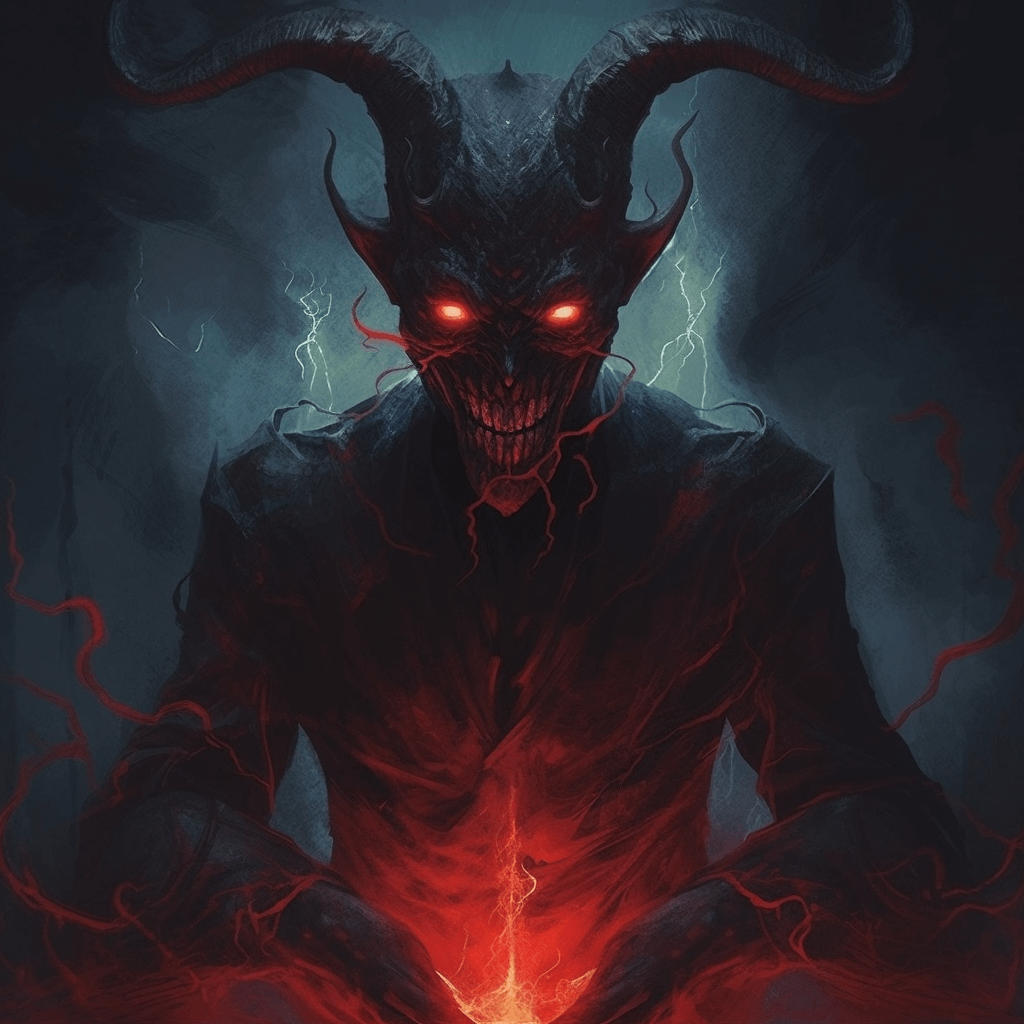
- Beelzebub: Often known as the ‘Lord of the Flies’, Beelzebub is a high-ranking demon who has been mentioned in religious texts and literature for centuries. Originating from Philistine gods, he later took on a demonic stature in Abrahamic religions. Stories say he tempts humans with pride and is considered a chief lieutenant in Hell’s hierarchy.
- Lucifer: The name that is synonymous with the epitome of evil, Lucifer’s fall from grace is a tale as old as time. Initially one of god’s most beloved angels, his pride and desire to be on par with the divine led to his banishment. In Christian traditions, he’s known as the fallen angel, the precursor to Satan, and the embodiment of pride and rebellion.
- Azazel: A captivating figure in various religious texts, Azazel is often linked with the ritual of the Day of Atonement. Depicted in the Book of Enoch as a fallen angel, he taught humans the art of warfare and cosmetics, leading them astray. He’s been imprisoned for his sins, awaiting judgment day.
- Mephistopheles: A name that echoes with Faustian tales, Mephistopheles is not necessarily the devil but a demon who serves him. He is cunning and mocks human ambition, often tempting people with power and knowledge. His portrayal in Goethe’s “Faust” as a sophisticated, witty, and manipulative figure has cemented his place in literary history.
- Bael: One of the principal demons named in the “Lesser Key of Solomon,” Bael is a king of Hell, commanding numerous legions. Often depicted with three heads – a man, a toad, and a cat – he possesses the power of invisibility.
- Asmodeus: A recurrent figure across various religious texts, Asmodeus stands as a symbol of lust. His most notorious tale is within the Book of Tobit, where he kills the husband of a woman named Sarah on their wedding night. Renowned as a king of demons, his power is vast and influence profound.
- Belial: His name translates to ‘worthless’ or ‘lawless,’ Belial is described as the leader of the Sons of Darkness in the Dead Sea Scrolls. He’s considered a potent demon in Christian demonology, representing impurity and lawlessness.
- Mammon: An embodiment of greed and material wealth, Mammon is not just a demon but a concept. The New Testament warns against the worship of Mammon, cautioning that one cannot serve both god and wealth.
- Abaddon: With a name that means ‘destruction,’ Abaddon is often considered the angel of death. In Christian apocalyptic writings, he’s the king of an army of locusts and is linked with the abyss.
- Pazuzu: This ancient Mesopotamian demon stands out with his fearsome appearance: a combination of human and animal parts, with wings, paws, and a scorpion’s tail. Although menacing, Pazuzu was invoked by the ancients to counteract the wicked forces of another demoness, Lamashtu.
- Legion: “For we are many.” This line encapsulates the essence of Legion, a collective of demons referenced in the New Testament. They infested a man until Jesus exorcised them, sending them into a herd of pigs.
- Samael: Often considered the ‘angel of death,’ Samael holds a complex position in religious texts. While some see him as a demon, others regard him as an archangel. His name might mean ‘Venom of God,’ suggesting both destructive and righteous aspects.
- Moloch: With tales rooted in the ancient Ammonite culture, Moloch is a god to whom child sacrifices were made, as depicted in the Old Testament. He’s often represented as a bull-headed figure with arms outstretched, awaiting offerings.
- Ahriman: From Zoroastrianism, Ahriman (or Angra Mainyu) is the destructive spirit, the counterpart to the creator god, Ahura Mazda. He represents chaos, darkness, and everything that opposes the divine order.
- Orobas: Hailing from the “Ars Goetia” in the “Lesser Key of Solomon,” Orobas is a prince of Hell. Riding a horse, he’s known to give true answers about past, present, and future and promises protection from other spirits. Contrary to his position, he’s often described as loyal to the conjurer and not deceptive.
- Baal: Often confused with Bael, Baal is an ancient Canaanite god. His name translates to “master” or “lord.” Over time, with the spread of monotheistic religions, Baal was demonized and later perceived as a powerful demon or even a false god.
- Marbas: As a great president of Hell, Marbas is known to possess dual abilities. While he can bestow knowledge and answer questions, he’s also known for causing or curing diseases. Often depicted as a lion, he can shape-shift into a human form.
- Paimon: Holding the title of a king in demonological sources, Paimon is one of the more obedient demons to Lucifer. With a loud and roaring voice, he has the power to influence and bind people’s will. Riding a camel, he’s often accompanied by a host of spirits.
- Buer: An intriguing entity, Buer is depicted with the upper body of a lion and five goat legs radiating like the spokes of a wheel. A great healer, he teaches natural and moral philosophy and can be called upon to cure ailments.
- Forneus: As a great marquis of Hell, Forneus is famed for his ability to teach rhetoric and languages. He can also make one beloved by foes and friends alike. Often visualized as a sea monster, he’s known to command twenty-nine legions of spirits.
- Gaap: Powerful and influential, Gaap is a president and prince of Hell. He specializes in teaching philosophy and liberal sciences, can cause love or hate, and even has the power to make one insensible or invisible. Moreover, he can transport people from one nation to another at a whim.
- Ipos: With an appearance combining an angel and a lion, Ipos is a prince and an earl of Hell. He grants wit and courage, making one bolder and more decisive, and can provide answers about the future.
- Vapula: As a powerful duke of Hell, Vapula takes the shape of a lion with the wings of a griffin. Beyond this fearsome exterior, he teaches the arts of philosophy, mechanics, and sciences, illuminating the minds of those who seek his guidance. With a following of thirty-six legions of demons, Vapula is an influential figure in the infernal realms.
- Zepar: Operating as a grand duke of Hell, Zepar might have a softer side, albeit with a twist. He focuses on making women fall in love with men, but there’s a catch: he makes them barren. Represented as a soldier in red attire, Zepar commands twenty-six legions.
- Purson: As one of the kings of Hell, Purson is no minor entity. He appears as a man with a lion’s face, carrying a vicious viper and riding a bear. His voice is full of mystery when he speaks, often accompanied by trumpets. He’s privy to the past, present, and even future events and is escorted by a host of spirits.
- Dantalion: Portrayed as a man with many faces, all of different people, Dantalion is a Duke of Hell. He teaches arts and sciences and has the unique ability to reveal the thoughts of those far away. A master manipulator, he can also influence and change the thoughts and decisions of individuals.
- Barbatos: Once an angel of the order of virtues, Barbatos is now a duke of Hell, ruling thirty legions. He can speak to animals, tell the future, and even conciliate rulers. With a hunter’s horn and the company of four kings, he strides through the forests, unveiling the hidden and the arcane.
- Sitri: As a prince of Hell, Sitri holds considerable sway over sixty legions. With a fiery countenance, he appears with a leopard’s head and a griffin’s wings. His unique capability? He can incite men and women to reveal their innermost desires and secrets, often of a sensual nature.
- Vine: Holding the title of a king and an earl of Hell, Vine has a dual visage—part lion, part human, often mounted on a black horse. This mighty entity can reveal things from the past, present, and even the future. He’s also known for unveiling the locations of witches and wizards, unmasking their deceptions. With a command over thirty-six legions, Vine’s influence is undeniable.
- Zagan: Zagan, a king and a duke of Hell, is depicted as a griffin-winged bull that turns into a man. Apart from his transformative abilities, he’s credited with the power to make the rich poor and vice versa. With his profound wisdom, he can also turn wine into water, blood into wine, and even make fools wise. Guiding thirty-three legions, his dominion is vast.
- Andras: One wouldn’t want to cross paths with Andras. As a grand marquis of Hell, he rides a wolf and wields a sharp saber. With an owl’s head on a man’s body, his appearance is as menacing as his purpose—to sow discord. He is often summoned to turn friends into enemies with his mischief and mayhem. Over thirty legions march under his banner.
- Valefar: Also known as Malaphar or Malephar, Valefar is a duke of Hell who commands ten legions. He takes the form of a lion with a donkey’s head, but his deceptive appearance is just the beginning. Valefar is known to be a good familiar, but he tricks those who trust him, leading them into theft. His cunning nature makes him a tricky ally or adversary.
Demons in Pop Culture: Their Evolution from Scriptures to Box Office Hits
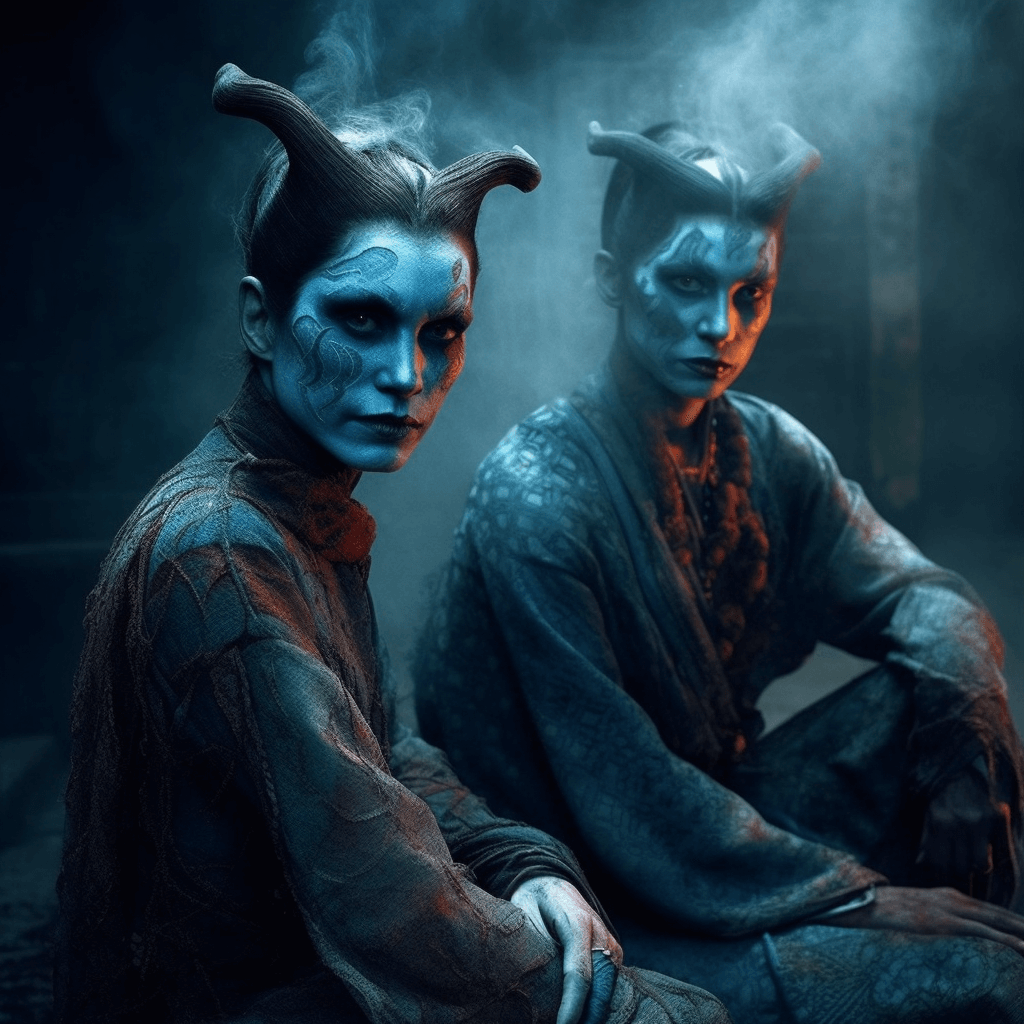
Demons, with their intricate tales of temptation and terror, have always captured the human imagination. Historically anchored in religious scriptures and ancient myths, these entities embodied fears, desires, and cautionary tales about the human condition. Over the centuries, as storytelling evolved, so did these demonic characters, finding their way from the pages of holy books to the heart of popular entertainment.
In the early days, religious scriptures portrayed demons as tempters, punishers, or testers of faith. Be it the biblical serpent in the Garden of Eden or the jinn in Islamic texts; they played pivotal roles in shaping the moral compass of societies.
The concept of demons isn’t exclusive to any culture or religion. They appear universally across various beliefs, from the asuras of Hinduism to the daimons of ancient Greek lore. These interpretations highlight humanity’s curiosity about the unknown and the eternal struggle between good and evil.
As the age of literature dawned, authors began to infuse demonic figures into their narratives. Plays like Christopher Marlowe’s “Doctor Faustus” introduced audiences to the charms and dangers of demonic pacts. With its dark romanticism, Gothic literature further elevated the status of demons, making them central figures of horror and desire.
But the advent of cinema truly catapulted demons into the mainstream. With its grand sets and gripping storylines, Hollywood turned these entities from mere shadows lurking in the background to full-fledged characters with depth, emotion, and, occasionally, even a sense of humor. Horror classics such as “The Exorcist” and “Rosemary’s Baby” showcased the terror these entities could invoke. At the same time, movies like “Good Omens” revealed their lighter, more humorous side.
Today, these once-feared beings are as likely to appear in a summer blockbuster as in a philosophical discourse. Their dynamic portrayal in pop culture reflects society’s evolving relationship with fear, morality, and the unknown. As we continue to reimagine these ancient beings, they serve as a mirror to our collective psyche, revealing our deepest anxieties and wildest fantasies.
Demons and Linguistics: The Meaning Behind the Names
While demon tales enthrall with their narratives of seduction, terror, and moral dilemmas, another layer to these tales that often goes overlooked is the very names of these entities. The etymology of demon names is a treasure trove of cultural, historical, and linguistic insights. As Shakespeare famously pondered, “What’s in a name?” When it comes to demons, the answer is—a whole lot!
“Names and words have power; they shape our reality, our perceptions, and even our feelings. Delving into the roots of demonic nomenclature isn’t just academic—it’s a journey into the soul of cultures and the fears and desires they’ve harbored over millennia.”
Take the name Lucifer, for instance. Originating from the Latin words’ lux’ (light) and ‘ferre’ (to bring), it translates to ‘Light-Bringer’ or ‘Morning Star.’ Once associated with Venus, the brightest star at dawn, this title transformed Christian scriptures, becoming synonymous with pride, rebellion, and, ultimately, a fallen angel.
The term ‘demon’ itself has evolved. Derived from the ancient Greek word daimon, it originally referred to a divine power or fate, not necessarily evil. Over time, religious and philosophical shifts transformed its connotations, molding the ‘daemon’ into the ‘demon’ we recognize today.
Another intriguing example is Beelzebub. This name is rooted in the Philistine god ‘Baal-Zebub,’ which translates to ‘Lord of the Flies.’ Scholars believe it was a deliberate Judaic mockery of the Philistine deity, turning ‘Baal the Exalted’ into a lord of something as insignificant as flies.
Similarly, the name Lilith, often associated with night demons, finds its origins in the Sumerian word ‘lilitu,’ signifying ‘wind’ or ‘spirit.’ Ancient texts depict her as a winged demoness, symbolizing the chaos of the wind, further solidifying the linguistic ties.
From Azazel, the ‘scapegoat’ in Hebrew rites, to Mephistopheles, a name with unclear origins but popularized by German folklore and Faustian tales, each demon’s name is a piece of a larger puzzle. They narrate tales of linguistic shifts, cultural exchanges, and the perennial human quest to label the unknown.
As we pull apart these names, letter by letter, syllable by syllable, we uncover layers of history, philosophy, and ancient cultural interplay. So, the next time you come across a demonic entity in a tale or text, remember: beneath that name lies a world of meaning waiting to be deciphered.
Using Demon Names Safely: A Cautionary Guide
The allure of the unknown is undeniable. Throughout history, humanity has been fascinated with the supernatural, including the dark, enigmatic realm of demons. Their names, carrying millennia of tales and power, often find a place in modern rituals, fiction, and even day-to-day conversations. But should we wield these names casually? Let’s explore the essential do’s and don’ts when uttering these ancient monikers.
Just as with anything potent and ancient, deep respect and awareness are required when diving into the world of demon names. It’s not about superstition—it’s about understanding and respect.
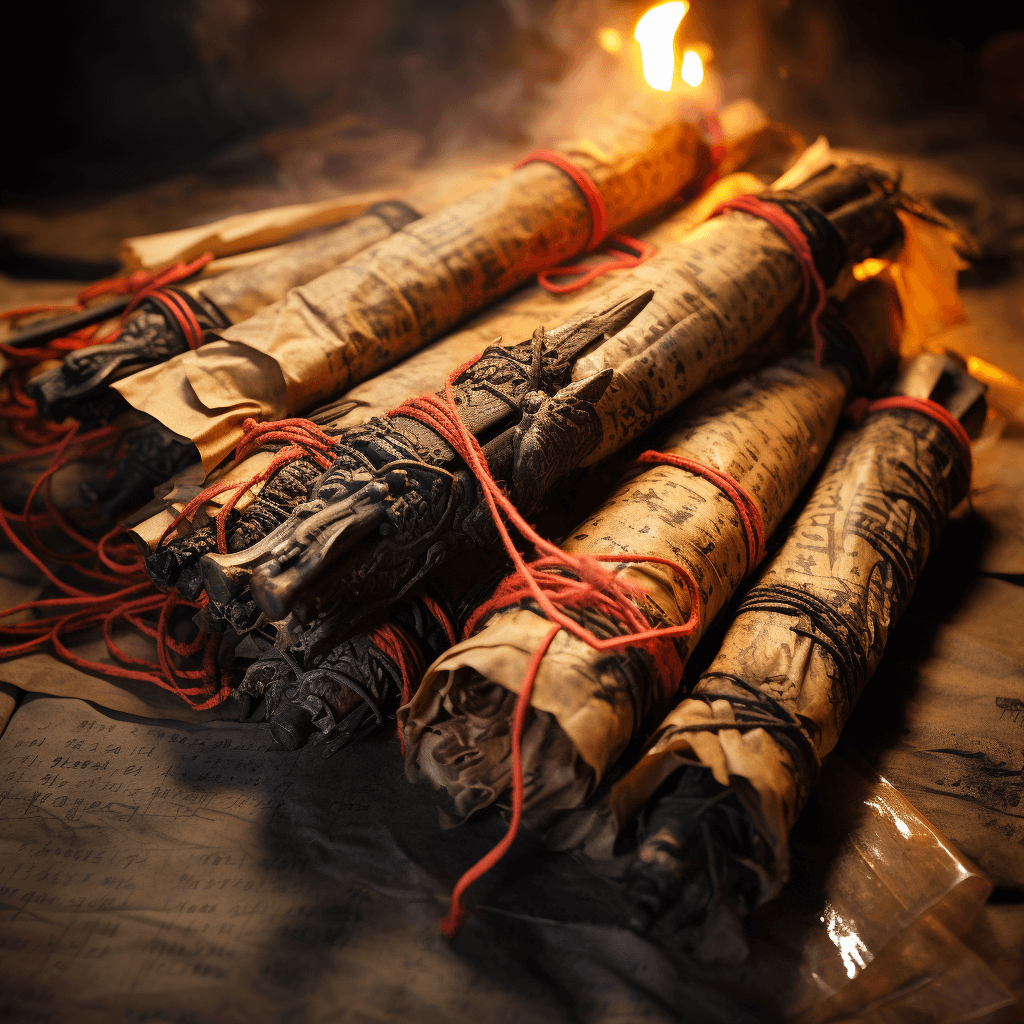
Do’s
- Educate Yourself: Before using a demon’s name, understand its history, origins, and the lore associated with it. Knowledge is power, and with it comes respect.
- Intention Matters: If you’re referencing these names in any rituals or ceremonies, be clear about your intent. A focused, respectful approach can make all the difference.
- Context is Key: If using demon names in fiction, art, or conversation, ensure that it’s appropriate to the context. A misplaced name can offend or mislead your audience.
Don’ts
- Don’t Use Casually: Avoid throwing around demon names flippantly. There’s a weight to these words, so use them thoughtfully.
- Avoid Mockery: While popular culture often uses these names in humor or parody, it’s always wise to approach such powerful entities with respect.
- Steer Clear of Unknown Rituals: Engaging in rituals without a clear understanding can be risky. Stick to what you know and always prioritize safety.
Many cultures believe in the power of naming. In numerous traditions, uttering a name grants you power over the entity it represents. This is why some names, especially those of supernatural beings, are spoken with caution or substituted with epithets.
To sum it up, the realm of demon names is a vast, intricate tapestry woven with tales, power, and caution. While they can be a source of fascination, intrigue, or even inspiration, it’s crucial to approach them with the reverence they command. Remember, some doors, once opened, can’t be easily closed.
Demon Gender Roles: A Comparative Study
Throughout history, cultures worldwide have spun tales of demons, fantastical creatures residing in the spiritual realm. But just as intriguing as the tales themselves is the representation of male and female demons in these stories. From powerful queens of the underworld to ferocious male entities, the gender roles assigned to these beings reflect societal norms, beliefs, and fears.
Origins of the Femme Fatale
The female demon, often portrayed as seductive and cunning, has deep historical roots. Characters like Lilith or Lamia are ancient examples of women with demonic attributes. But why this portrayal? Historically, women with independent streaks or those who resisted societal roles were seen as threats. These traits were associated with the supernatural in many cultures, creating a narrative where powerful, independent women were demonized.
The Mighty Male Demon
On the other side, male demons like Beelzebub or Lucifer are often shown as rulers, dominant forces of chaos and destruction. They’re embodiments of strength, power, and control, aligning with traditional male attributes lauded by societies of yore.
Many male demon names, when translated, mean “king,” “prince,” or refer to some form of high-ranking authority, further emphasizing their perceived dominance.
The Evolution Over Time
As societies changed, so did the representation of demons. In more modern tales, female demons evolved from seductresses to powerful entities with depth and agency. Male demons, too, started showing vulnerabilities, becoming more complex characters rather than just embodiments of raw power.
Modern pop culture, movies, books, and shows now offer a more nuanced look at demon gender roles, challenging the older, more binary perspectives.
The Interplay of Fear and Attraction
One consistent theme, irrespective of gender, is the mix of fear and allure that demons represent. Whether it’s a female demon’s charm or a male entity’s might, they symbolize forbidden allure, captivating the human psyche.
Understanding these representations provides a mirror into human society, reflecting our values, biases, and, most importantly, our endless fascination with the unknown.
While the world of demons might be shadowy, the tales they inspire light up the human imagination, making us ponder the deeper, darker recesses of our minds.
Elemental Demons Explained: Fire, Water, Earth, and Air
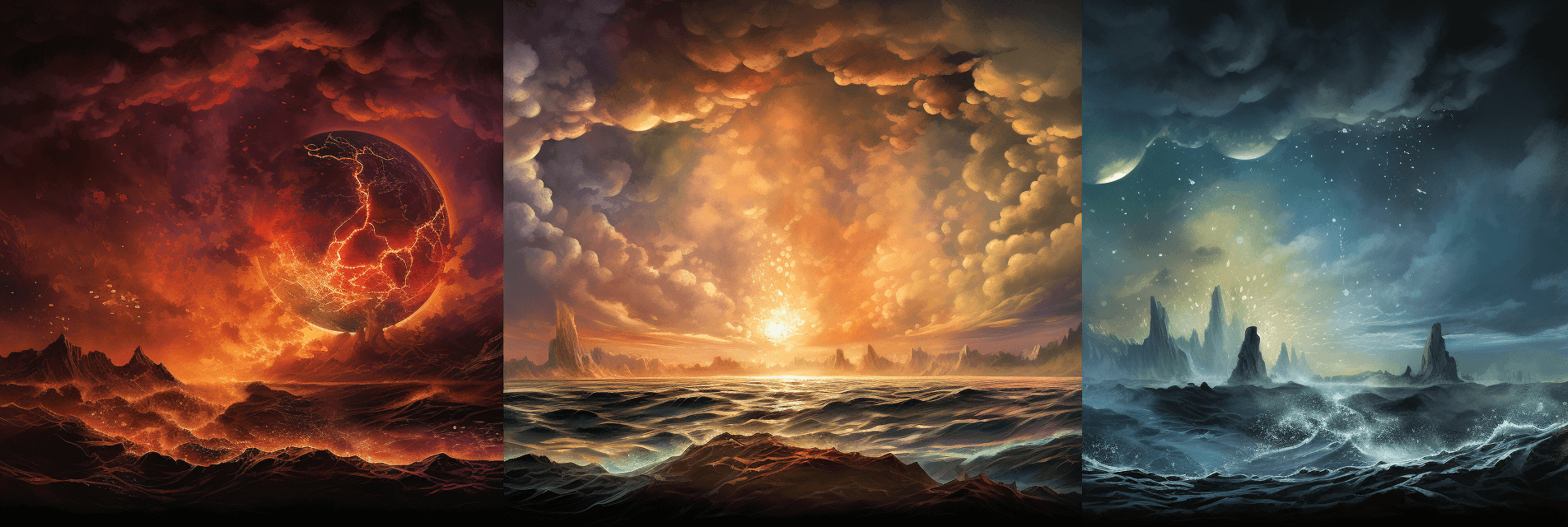
Regarding the intricate dance between the spiritual and natural realms, elemental demons take center stage. By weaving the forces of nature into their very essence, these entities resonate with the ancient beliefs of many civilizations. Let’s delve into the mystical relationship between demon names and the elements and see how they shape stories across various cultures.
Fire: The Flame Spirits
Fire, a symbol of passion, destruction, and rebirth, is closely associated with many demons. Its uncontrollable nature and warming embrace make it a fascinating element.
- Azazel: Often represented as a demon of the desert, his presence is like the scorching heat, bringing both illumination and desolation.
- Ifrit: Originating from Arabian lore, these are fiery spirits, sometimes seen as evil beings born from the flames.
Water: The Abyssal Entities
Water, with its ever-changing, fluid nature, represents emotion, depth, and mystery. The entities associated with it are as deep and enigmatic as the ocean.
- Leviathan: Often depicted as a massive sea serpent, this entity symbolizes the vastness and unpredictable nature of the oceans.
- Rusalka: Slavic water spirits, these female entities inhabit lakes or ponds, representing both the allure and danger of water.
Earth: Guardians of the Terrain
Earth embodies stability, nurturing, and strength. The demons tied to this element often represent foundational forces and nature’s enduring power.
- Belphegor: Sometimes associated with innovations and inventions, this entity is like the fertile ground from which ideas sprout.
- Gnomes: While not always demonic, these earth spirits from European myth represent the hidden treasures and secrets of the land.
Air: Whispers of the Wind
The ever-present yet intangible air signifies freedom, intellect, and the unseen. Its associated entities are often elusive and swift, just like the breeze.
- Pazuzu: An Assyrian/Babylonian wind demon, he brings forth storms, representing the explosive nature of wind.
- Sylphs: Originating from alchemical traditions, these air spirits are seen as protectors, embodying the gentler breezes and whispers of secrets.
Connecting demon names with elements is about more than just classifying them. It reflects how ancient cultures tried to understand and personify the natural world around them. By attributing familiar behaviors and characteristics to these entities, they made the vast, complex universe a little more understandable, one tale at a time.
Why We Love Demon Tales: The Psychology Behind the Fascination
From bone-chilling horror films to awe-inspiring myths, tales featuring demonic forces have transfixed audiences for millennia. But what is it about these narratives that draw us in so powerfully? Let’s journey into the corridors of our psyche to unearth the roots of our eternal attraction to stories of demons and the battle between good and evil.
The Allure of the Unknown
The enigmatic realm of the supernatural, with its eerie entities and inexplicable phenomena, offers a tantalizing escape from our daily reality. Our curiosity about the unseen and the thrill of the unpredictable make demon tales a riveting experience.
The Eternal Battle: Good vs. Evil
The dichotomy between light and dark, virtue and vice, is a cornerstone of human storytelling. This binary tug-of-war resonates deeply within us, echoing our internal struggles and moral dilemmas.
- Personal Triumphs: When we read about heroes defeating evil forces, it’s hard not to draw parallels with our battles – be it overcoming personal challenges or resisting temptations.
- Hope and Redemption: These tales often center around redemption and the possibility of change, reinforcing our belief in second chances and the transformative power of good.
A Mirror to Our Fears
Demons, in many stories, personify our deepest fears and anxieties. Whether it’s a demon representing societal ills or personal demons symbolizing inner turmoil, these narratives help us confront and process these daunting feelings.
The Cultural Tapestry
Stories of demons serve as cultural markers, preserving age-old beliefs, traditions, and societal values. They act as windows into the collective psyche of different civilizations, offering insights into their hopes, fears, and moral frameworks.
A Shared Experience
Engaging with these stories, especially in communal settings around a campfire or cinema, fosters a sense of community. The shared emotions – fear, hope, relief – fortify social bonds and create lasting memories.
Ultimately, our fascination with demon tales is a testament to the power of storytelling. These narratives, steeped in intrigue and emotion, serve as both mirrors reflecting our innermost feelings and bridges connecting us to the vast cosmos of human experience. Whether it’s for introspection, catharsis, or sheer entertainment, it’s no wonder we remain captivated by the dance of shadows in the world of demons.

